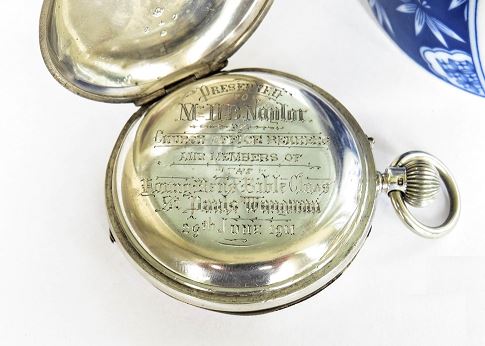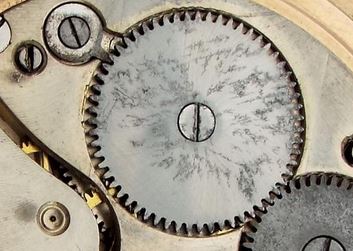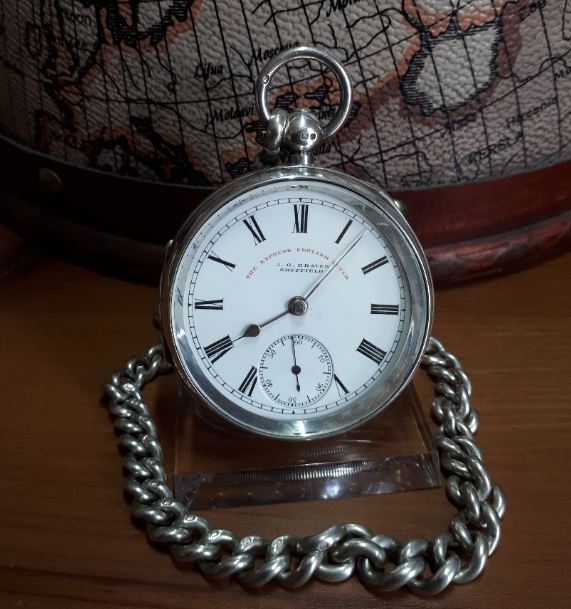Last updated on July 3, 2024
In this post, I am taking a look at the things I try to avoid when adding to my collection. Ultimately, you should purchase an antique watch that appeals to you. However, here are 12 factors to consider when buying antique watches.
1. 7 jewel movements
A jewel in an antique watch movement is there as a bearing. It provides a hard-wearing, low-friction pivot point for many of the moving parts in the movement. Generally, the higher the jewel count, the better the quality of the watch. At the budget end of the scale, there are 7-jewel watches, which have jewels in the balance and on the lever pallets. 7-jewel watches are more prone to wear and tear than those with a higher jewel count. The gear train on an antique pocket watch operates under a lot of tension from the mainspring. As the watch runs, the gears turn at various speeds and the steel axle of the gear gradually wears away at the side of the hole that it rests in. This does not occur if jewelled bearings are used.
The steel wheel pivots will eventually enlarge the hole in the brass plate just like a tiny file. The enlarged hole will tend to be oval in shape because the pivot is being pushed by spring tension in a fixed direction. Once the hole becomes oval, the arbor (axle) of the wheel begins to wander off vertically. This impairs the wheel’s ability to inter-mesh correctly with the other gears. The gear-train is no longer able to function correctly and the watch loses accuracy. In severe cases, the gear train will bind and the watch will stop.

7-jewel movements are likely to require more frequent servicing and repair costs than those watches with higher jewel counts. Generally, it is best to focus on buying watches with 15 or more jewels.
2. Verge and cylinder movements
Verge and cylinder movements were superseded by the more reliable lever escapement in the mid-19th century. The verge was the earliest type of movement. The name verge comes from the Latin virga, meaning stick or rod. The rod or stick is the balance staff, which acts as the axle for the balance wheel. There are two pallets on the balance staff which engage with the teeth on the verge escape wheel. Verge watches are very sensitive to changes in the drive force and they tend to slow down as the mainspring unwinds. All verge watches required a fusee to offset this characteristic.
Verge watches were highly susceptible to wear and tear. They tended to accelerate as the crown wheel and the pallets wore down. It is not uncommon for worn verge watches to gain several hours per day.
The cylinder escapement was also known as the horizontal escapement, in contrast to the vertical verge escapement that preceded it. The cylinder escapement was never commonly embraced by English watchmakers. However, it was widely used in Switzerland until the early 20th century.
The cylinder escapement, just like the verge, suffers from wear and tear. Some high-end watchmakers were able to overcome this issue by making the cylinder from ruby, but this was obviously very expensive.
If you intend to buy an antique pocket watch for regular use it is best to avoid verge or cylinder movements. The cost of ongoing repairs and servicing could prove expensive.
3. Engravings
This is my opinion, but I think that personalised engraving on antique watches detracts from their value. Most collectors will want their timepieces to be as authentic as possible and an engraving is obviously a modification to the original timepiece. This clearly lessens the demand, the price and therefore the resale value.
Sometimes the engraving can be as simple as the owner’s initials engraved on the back of the case. Other times the engraving can be less visible as it is engraved on the inner dust cover. Either way, it identifies a previous owner and personally makes it feel less like I am the owner of the antique timepiece. Therefore, I have avoided buying engraved antique watches. I wouldn’t even consider buying an antique watch that had my own initials on it. I would prefer that these timepieces were kept and treasured as family heirlooms.

There could be exceptions for engraved antique watches owned by famous people or those with significant connections. For instance, collectors of militaria might be interested in owning an engraved antique watch owned by an officer of a particular regiment. Additionally, engraved watches were often given as retirement gifts. Therefore an engraving that showed an association with a particular company might have a high value to certain collectors.
4. Corroded movements
Pitting corrosion affects metals and alloys such as steel and brass. It is usually constrained to specific areas on the movement. Normally, it is caused by a corrosive solution containing chlorides, such as seawater. However, humidity or fresh water can also combine with other contaminants to form a corrosive compound. Any sign of pitting on the watch movement must be considered damage. These timepieces should be avoided as the watch has likely been exposed to water.
5. Non-original components
I came across a watch recently with the name, Thos Russell & Son on the dial. I have been looking for some time for an antique pocket watch from this maker. However, there was something not quite right about this watch. One thing I had noted when looking at other Thos Russell & Son watches, was that the name was nearly always engraved on the movement. In this case, it wasn’t, which left me wondering if the dial was a replacement from a donor watch. It was still a functional timepiece, but its originality was in doubt. The hands can sometimes be replaced, as can the crystal. However, these have less impact on the originality than the dial, case or movement. Re-cased watches, such as side-winders, should also be avoided if you are after an original timepiece.
6. Poor time keeping & power reserve
If the antique watch is going to be a practical timepiece then it is going to need to function with a degree of accuracy. It is reasonable to expect an accuracy of two to three minutes per day from an antique watch. It is not impossible for it to be considerably more accurate if it is well-maintained, serviced and regulated. Most of the watches in my collection run to within a minute’s accuracy a day. The power reserve is also important and ideally should be 24-hours or more from a full wind. Avoid watches that run accurately, but stop after only a few hours. Always confirm the accuracy and power reserve from the seller before buying.
7. The name on the dial
The name on the dial is not always the name of the actual watchmaker. There are three different types of ‘watchmakers’. First, there are the manufacturers who make the components and blank (ébauche) movements. Second, there are the watch finishers (établisseurs), who buy the components and assemble them. Thirdly, there are the watch retailers, who style themselves as watchmakers, by printing their name on the dial. Note, that some of the manufacturers also made complete watches. Often, the name of the manufacturer, or reference number, will be found on the movement, but engraved on the dial side.
8. Damage to dials
A good quality antique watch will have an enamel dial. Originally, watch dials were made of metal plate. However, when vitreous enamel became available during the 18th century, it quickly became the preferred material. It is durable and hard-wearing, but susceptible to hairlines cracks over time. In my opinion, these cracks are considered patina and add to the character of the watch. Sometimes cleaning can make these hairlines cracks less visible. Visible repairs to a watch dial, should be considered damage and therefore avoided. Lastly, the dial will be covered by a crystal lens. If original, the lens will be mineral glass, if it is a later replacement it is likely to be acrylic. In my opinion, both types are acceptable and relatively inexpensive to replace.
9. Poor case condition
Light scratches and minor dents on the case are, in most cases, considered patina. This is increasingly being considered important by serious collectors. It shows character and gives each watch a unique look. However, deep dents, damage to hinges and heavy scratching must be considered damage and should be avoided at all costs. Likewise, for hunter or demi-hunter cases the lid should open when the crown is depressed and shouldn’t require assistance. Additionally, the case back and inner dust covers should open and close properly without being forced.
10. Incorrect terminology
One of the things to look out for on online auctions sites is incorrect terminology or information. It is a certain sign that the seller is either not familiar with antique watches or they are trying to deceive their buyers. If something doesn’t seem right about a description, abandon the sale and continue to look elsewhere. It is best to identify a couple of trusted dealers and buy exclusively through them.
I have seen a number of trench watches where the watchmaking has been attributed to Francois Borgel, which is completely incorrect. Borgel only made watch cases and never the watches themselves. Also, I have seen numerous examples where the dates have been incorrect based on the hallmarks. In every instance, the watch was listed with the date shown as much older than the hallmark. When sellers make such obvious errors, you wonder what else might be wrong with the watch.
11. Un-serviced watches
It is generally best to buy an antique pocket watch that you know has been serviced. Quite often the seller will also provide a year-long warranty if they are offering a serviced watch. Generally, a watch that is used regularly will require a service approximately every 5 years to ensure it is running accurately. A serviced antique watch will give some peace of mind and should guarantee several years of accurate timekeeping.
12. Buy what appeals to you. Don’t buy for investment purposes.
Antique watches are going up in value, by some estimates, as much as 5% per year. That is better than money in the bank, and in many cases, better than the stock market. However, if you are buying an antique pocket watch to recognise a significant life event, it is the sentimental value that is most important. Choose an antique watch that meets the requirements above and forget about the investment value. After all, you are buying an antique timepiece that you hope will become a family heirloom.
The HMRC has an asset class known as wasting assets. These are items that have an expected life of 50 years or less. These are exempt from capital gains tax. This includes items of machinery, such as antique watches. In some cases, you may be lucky in selecting an antique watch that has an appreciating value. However, focus on buying something that appeals to you.
Related content
A beginner’s guide to antique pocket watches.
5 things you should know before purchasing an antique watch.
A list of additional posts regarding antique watches can be found on the Guides page.

